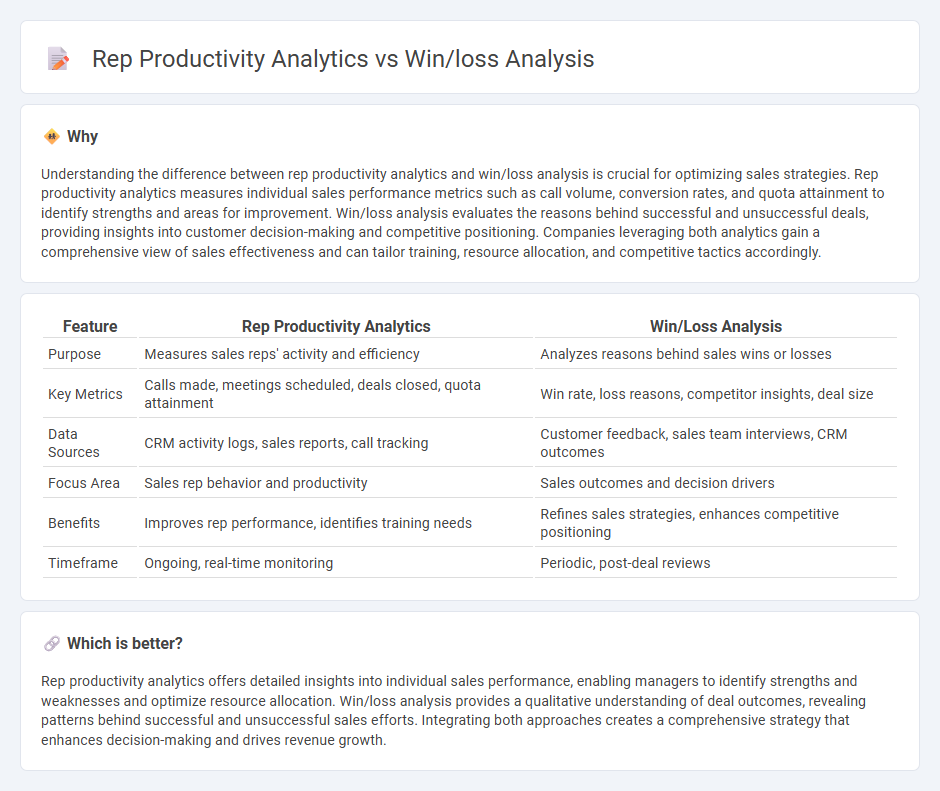
Sales rep productivity analytics focuses on measuring individual performance metrics such as call volume, conversion rates, and average deal size to optimize sales team efficiency and drive revenue growth. Win/loss analysis examines the reasons behind closed deals, evaluating competitive positioning, customer feedback, and sales strategies to improve future outcomes. Explore how combining these insights can enhance your overall sales strategy and accelerate business success.
Why it is important
Understanding the difference between rep productivity analytics and win/loss analysis is crucial for optimizing sales strategies. Rep productivity analytics measures individual sales performance metrics such as call volume, conversion rates, and quota attainment to identify strengths and areas for improvement. Win/loss analysis evaluates the reasons behind successful and unsuccessful deals, providing insights into customer decision-making and competitive positioning. Companies leveraging both analytics gain a comprehensive view of sales effectiveness and can tailor training, resource allocation, and competitive tactics accordingly.
Comparison Table
| Feature | Rep Productivity Analytics | Win/Loss Analysis |
|---|---|---|
| Purpose | Measures sales reps' activity and efficiency | Analyzes reasons behind sales wins or losses |
| Key Metrics | Calls made, meetings scheduled, deals closed, quota attainment | Win rate, loss reasons, competitor insights, deal size |
| Data Sources | CRM activity logs, sales reports, call tracking | Customer feedback, sales team interviews, CRM outcomes |
| Focus Area | Sales rep behavior and productivity | Sales outcomes and decision drivers |
| Benefits | Improves rep performance, identifies training needs | Refines sales strategies, enhances competitive positioning |
| Timeframe | Ongoing, real-time monitoring | Periodic, post-deal reviews |
Which is better?
Rep productivity analytics offers detailed insights into individual sales performance, enabling managers to identify strengths and weaknesses and optimize resource allocation. Win/loss analysis provides a qualitative understanding of deal outcomes, revealing patterns behind successful and unsuccessful sales efforts. Integrating both approaches creates a comprehensive strategy that enhances decision-making and drives revenue growth.
Connection
Rep productivity analytics provides critical insights into individual sales performance by measuring key metrics such as conversion rates, deal cycle length, and activity levels. Win/loss analysis complements this by evaluating the outcomes of sales opportunities to identify patterns in customer decisions and competitive positioning. Integrating these data-driven approaches enables sales leaders to pinpoint strengths and weaknesses, optimize training programs, and refine sales strategies for improved overall effectiveness.
Key Terms
**Win/Loss Analysis:**
Win/Loss Analysis evaluates sales outcomes by examining reasons behind deals won or lost, providing actionable insights to refine sales strategies and improve close rates. It emphasizes qualitative data from customer feedback, competitor comparisons, and market conditions to identify strengths and weaknesses in the sales process. Explore Win/Loss Analysis techniques to enhance sales effectiveness and decision-making.
Deal Outcome
Win/loss analysis evaluates deal outcomes by examining factors that led to successful or unsuccessful sales, offering insights into customer decision behaviors and competitive positioning. Rep productivity analytics measures individual sales representatives' performance through metrics like deals closed, average deal size, and sales cycle duration, enhancing efficiency and resource allocation. Explore how integrating both approaches can optimize sales strategies and improve overall deal success rates.
Reason Codes
Win/loss analysis identifies key factors driving sales outcomes by examining Reason Codes, which categorize why deals are won or lost. Rep productivity analytics measures individual sales performance, focusing on metrics like call volume and closing rates, but Reason Codes provide deeper insight into qualitative aspects influencing those numbers. Explore how integrating Reason Codes with productivity analytics can enhance sales strategies and decision-making.
Source and External Links
Win-Loss Analysis: A Comprehensive Guide - This guide provides steps for conducting a win-loss analysis, focusing on data collection, calculating win/loss ratios, and applying insights to improve sales strategies.
Four Pillars of Effective Win Loss Analysis - This article outlines the four pillars of effective win-loss analysis, emphasizing leadership, data quality, synthesis, and adoption.
Win/Loss Analysis and Optimization - This resource explores the purpose and benefits of win-loss analysis, focusing on understanding customer acquisition and retention strategies.
 dowidth.com
dowidth.com